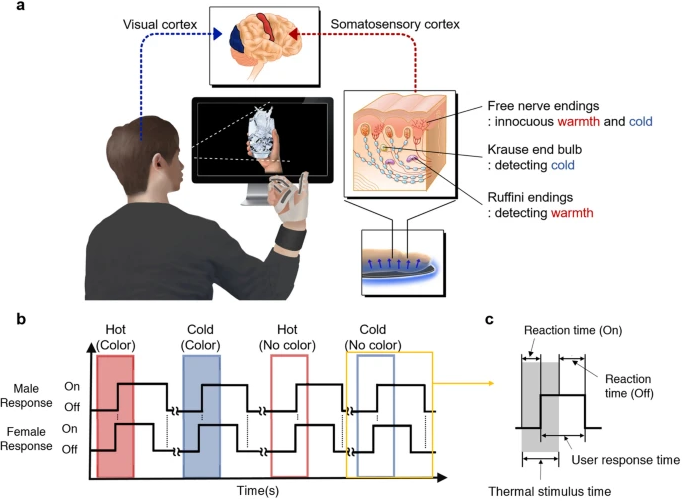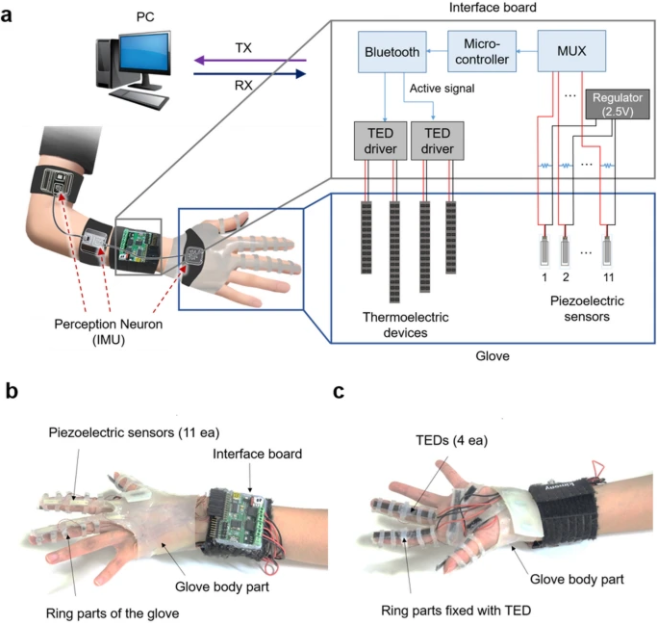This New Haptic VR Glove Provides a Realistic Warm/Cold Feeling
This thermoelectric glove innovation which transmits thermal stimuli in the virtual worlds promising users deeper immersion in VR.
There have been several development approaches for thermal generation technology in VR that are intended to perceive the feeling of hot or cold in VR.
There are experiments such as the LiquidMask, the futuristic promise of a brain interface as well as various prototypes that have shown some good potential such as ThermoReal, a thermoelectric device developed by TEGway a spinoff of the Korean Advanced Institute of Science and Technology (KAIST), which was demo’d during the CES 2020.
Now researchers at the KAIST have come up with a new novel glove for thermal perception in VR. It is a self-sufficient thermal glove which is designed to enable users to feel virtual temperatures in real-time.

The base platform of glove is from the previously developed motion-sensing glove which was embedded with piezoelectric sensors at its backhand and each finger to measure the strain on the glove induced by hand motions.
The real-time thermal display of the thermal stimuli glove has been achieved with customized flexible TEDs and it has the suitable form factor to support the finger movements and also target a minimum curvature radius drawing from the manufacture process of KAIST’s previous research on haptic gloves.
In the latest gloves, flexible thermoelectric devices (TEDs) are used as thermal displays based on the Peltier effect. The TEDs have been embedded on the front side of the user’s thumb, index finger, the middle finger along with the upper part of the palm where they generate a temperature difference that shows a cold or hot state when a user comes into contact with an object in virtual reality.
The gloves are standalone and will work without any external connections or sources. The user’s hand movements are transmitted by the piezoelectric sensors while the TEDs have been integrated into the glove replacing the external thermoelectric devices in the previous research.

There is an interface board with a power supply below the wrist which wirelessly communicates with the computer or the virtual reality software. When a user touches an object with a temperature difference in the virtual environment, this will be transmitted to the interface board that, in turn, controls the thermoelectric sensors embedded in the glove.
These sensors subsequently trigger thermal stimuli on the user’s skin thereby transmitting the simulated temperatures. At the same, the wearer’s own body temperature is measured and factored in for the temperature simulation. This system works in real time with the sensors capable of simulating a temperature difference of up to 10 degrees in less than a half a second.
Are these haptic gloves ready for the consumer market?
The researchers at KAIST have so far built and tested the thermal stimuli glove as a prototype to research the extent to which perception of temperatures can improve the VR experience. The fact that simultaneous perception of temperatures makes visual stimuli a lot more realistic provided they are transmitted in real-time shouldn’t be a surprise or a groundbreaking discovery. The haptics field has been with us for quite some time and some devices have actually gone into production and deployment in the market.
For the time being, this glove is only a prototype and can be put into university test series. The glove must also be individually adapted for the respective hand shape of the user which for the time being, does not really make the glove appealing for the consumer market.
Additionally, we aren’t really sure whether end users really want to wear VR gloves or suit in addition to the traditional VR setup of headset and controllers when immersing themselves into virtual experiences, particularly if the gloves provide just a slight improvement in the immersion. It is still a new terrain.
Generally, VR gloves and other haptic devices are still at an intermediate research phase. There is the lingering question as to whether the VR gloves are really useful for Virtual Reality. Even for movement tracing and haptic feedback, VR gloves are only useful to a limited extent even though there is some good potential in products such as the Manus Prime Haptic Gloves. For hand tracking such as in Oculus Quest, there are now better and more novel ways to bring your hands in play in the virtual environment. Perhaps, the solution to deeper immersion in VR will be a direct stimulation via a brain-computer interface.
Research is ongoing on this front as well. Elon Musk is already researching a direct manipulation of the brain with Neuralink while Valve’s Gabe Newell believes a brain interface isn’t too far away.
Source: Nature.com
https://virtualrealitytimes.com/2020/08/23/this-new-haptic-vr-glove-provides-a-realistic-warm-cold-feeling/https://virtualrealitytimes.com/wp-content/uploads/2020/08/Thermal-Stimuli-Glove-600x441.pnghttps://virtualrealitytimes.com/wp-content/uploads/2020/08/Thermal-Stimuli-Glove-150x90.pngHapticsHardwareTechnologyThis thermoelectric glove innovation which transmits thermal stimuli in the virtual worlds promising users deeper immersion in VR. There have been several development approaches for thermal generation technology in VR that are intended to perceive the feeling of hot or cold in VR. There are experiments such as the LiquidMask, the...Sam OchanjiSam Ochanji[email protected]EditorVirtual Reality Times - Metaverse & VR
